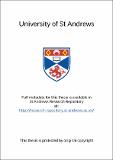Files in this item
Negotiating small differences : conservation organisations and farming in Islay
Item metadata
| dc.contributor.advisor | Smout, T. C. (T. Christopher) | en |
| dc.contributor.advisor | Crook, Tony | en |
| dc.contributor.advisor | Dilley, Roy | en |
| dc.contributor.author | Whitehouse, Andrew J. | en |
| dc.coverage.spatial | 306 p : ill. (chiefly col.), col. maps 30 cm. | en |
| dc.date.accessioned | 2021-04-08T08:57:23Z | |
| dc.date.available | 2021-04-08T08:57:23Z | |
| dc.date.issued | 2005 | |
| dc.identifier.uri | https://hdl.handle.net/10023/21878 | |
| dc.description.abstract | This thesis concerns the relationship between two conservation organisations (Scottish Natural Heritage and the Royal Society for the Protection of Birds) and farming people in Islay, Scotland. The historical discourse of this entangled relationship is constructed from interviews, archival research, meetings and events recorded during sixteen months of fieldwork. The principal contestations concerned designated areas for conservation and crop damage caused by protected geese. This historical discourse developed alongside fluctuations in Islay's agricultural economy and concerns over the future of farming. Five sketches introduce the discourse but the analysis is then developed around three symbols that represented conservation and farming - an RSPB nature reserve, designated areas and the goose problem. Farmers' relations with land, government and other farmers are also described in order to reveal their understandings of change and the outside world -both of which conservation organisations came to represent. The thesis emphasises a perceptual, fluid and diachronic approach to the negotiation of difference and relations of power rather than notions of belonging and marginalisation. It describes how individuals and organisations explained and negotiated difference and how they utilised symbols both to situate themselves and to develop future strategies. Bateson's concepts of tautology and abduction are then used to tease out the underlying assumptions that underpin these practices. This analysis reveals models of connection between the local/ outside world and continuity/ change and the ways in which these were played off against one another in discourse. Although conservationists were often identified with change and the outside world, this identification was gradually reduced because farmers needed to renegotiate their livelihoods in the light of deteriorating economic conditions and also because conservation came to be more associated with the local and with continuity. Because their power could then seem either more negotiable or more inevitable, the influence of conservationists grew. | en |
| dc.language.iso | en | en |
| dc.publisher | University of St Andrews | en |
| dc.subject.lcc | QH77.G7W5 | |
| dc.subject.lcsh | Scottish Natural Heritage | en |
| dc.subject.lcsh | Royal Society for the Protection of Birds | en |
| dc.subject.lcsh | Nature conservation--Scotland--Islay | en |
| dc.subject.lcsh | Natural areas--Scotland--Islay | en |
| dc.subject.lcsh | Conservationists--Scotland--Islay | en |
| dc.subject.lcsh | Farmers--Scotland--Islay | en |
| dc.title | Negotiating small differences : conservation organisations and farming in Islay | en |
| dc.type | Thesis | en |
| dc.type.qualificationlevel | Doctoral | en |
| dc.type.qualificationname | PhD Doctor of Philosopy | en |
| dc.publisher.institution | The University of St Andrews | en |
This item appears in the following Collection(s)
Items in the St Andrews Research Repository are protected by copyright, with all rights reserved, unless otherwise indicated.

